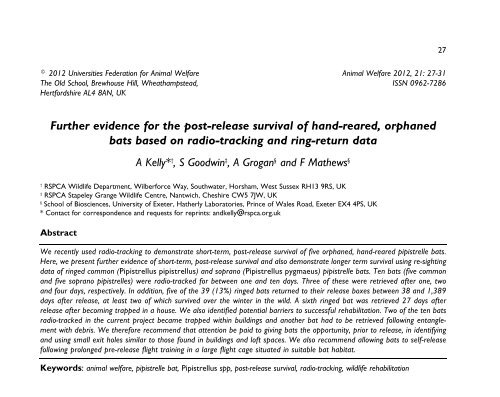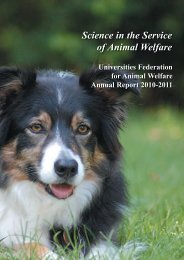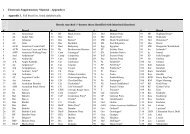Further evidence for the post-release survival of hand-reared ...
Further evidence for the post-release survival of hand-reared ...
Further evidence for the post-release survival of hand-reared ...
You also want an ePaper? Increase the reach of your titles
YUMPU automatically turns print PDFs into web optimized ePapers that Google loves.
© 2012 Universities Federation <strong>for</strong> Animal Welfare<br />
The Old School, Brewhouse Hill, Wheathampstead,<br />
Hert<strong>for</strong>dshire AL4 8AN, UK<br />
27<br />
Animal Welfare 2012, 21: 27-31<br />
ISSN 0962-7286<br />
<strong>Fur<strong>the</strong>r</strong> <strong>evidence</strong> <strong>for</strong> <strong>the</strong> <strong>post</strong>-<strong>release</strong> <strong>survival</strong> <strong>of</strong> <strong>hand</strong>-<strong>reared</strong>, orphaned<br />
bats based on radio-tracking and ring-return data<br />
A Kelly* † , S Goodwin ‡ , A Grogan § and F Ma<strong>the</strong>ws §<br />
† RSPCA Wildlife Department, Wilber<strong>for</strong>ce Way, Southwater, Horsham, West Sussex RH13 9RS, UK<br />
‡ RSPCA Stapeley Grange Wildlife Centre, Nantwich, Cheshire CW5 7JW, UK<br />
§ School <strong>of</strong> Biosciences, University <strong>of</strong> Exeter, Ha<strong>the</strong>rly Laboratories, Prince <strong>of</strong> Wales Road, Exeter EX4 4PS, UK<br />
* Contact <strong>for</strong> correspondence and requests <strong>for</strong> reprints: andkelly@rspca.org.uk<br />
Abstract<br />
We recently used radio-tracking to demonstrate short-term, <strong>post</strong>-<strong>release</strong> <strong>survival</strong> <strong>of</strong> five orphaned, <strong>hand</strong>-<strong>reared</strong> pipistrelle bats.<br />
Here, we present fur<strong>the</strong>r <strong>evidence</strong> <strong>of</strong> short-term, <strong>post</strong>-<strong>release</strong> <strong>survival</strong> and also demonstrate longer term <strong>survival</strong> using re-sighting<br />
data <strong>of</strong> ringed common (Pipistrellus pipistrellus) and soprano (Pipistrellus pygmaeus) pipistrelle bats. Ten bats (five common<br />
and five soprano pipistrelles) were radio-tracked <strong>for</strong> between one and ten days. Three <strong>of</strong> <strong>the</strong>se were retrieved after one, two<br />
and four days, respectively. In addition, five <strong>of</strong> <strong>the</strong> 39 (13%) ringed bats returned to <strong>the</strong>ir <strong>release</strong> boxes between 38 and 1,389<br />
days after <strong>release</strong>, at least two <strong>of</strong> which survived over <strong>the</strong> winter in <strong>the</strong> wild. A sixth ringed bat was retrieved 27 days after<br />
<strong>release</strong> after becoming trapped in a house. We also identified potential barriers to successful rehabilitation. Two <strong>of</strong> <strong>the</strong> ten bats<br />
radio-tracked in <strong>the</strong> current project became trapped within buildings and ano<strong>the</strong>r bat had to be retrieved following entanglement<br />
with debris. We <strong>the</strong>re<strong>for</strong>e recommend that attention be paid to giving bats <strong>the</strong> opportunity, prior to <strong>release</strong>, in identifying<br />
and using small exit holes similar to those found in buildings and l<strong>of</strong>t spaces. We also recommend allowing bats to self-<strong>release</strong><br />
following prolonged pre-<strong>release</strong> flight training in a large flight cage situated in suitable bat habitat.<br />
Keywords: animal welfare, pipistrelle bat, Pipistrellus spp, <strong>post</strong>-<strong>release</strong> <strong>survival</strong>, radio-tracking, wildlife rehabilitation
28 Kelly et al<br />
Table 1 Characteristics <strong>of</strong> radio-tracked bats.<br />
Species Sex Ring number Admission weight (g) Release weight (g) Forearm length (mm) Condition index<br />
Common F Z3283 2.7 5.2 31.4 0.17<br />
Common F Z3288 2.9 6.0 32.4 0.19<br />
Common F Z2945 2.7 4.5 30.1 0.15<br />
Common M Z3255 2.2 4.3 27.5 0.16<br />
Common M Z3259 2.6 5.1 31.0 0.16<br />
Soprano F Z3263 1.9 4.8 30.2 0.16<br />
Soprano F Z3278 1.4 5.2 31.7 0.16<br />
Soprano F Z2939 2.3 5.1 31.6 0.16<br />
Soprano M Z3251 1.9 4.9 30.8 0.16<br />
Soprano M Z3281 2.3 4.8 32.2 0.15<br />
Condition index was calculated as bodyweight/<strong>for</strong>earm length.<br />
Figure 1<br />
<strong>release</strong> flight training in a large flight cage. More<br />
recently, Serangeli et al (2012) demonstrated <strong>post</strong><strong>release</strong><br />
<strong>survival</strong> <strong>of</strong> between four to 14 nights <strong>for</strong> 19 <strong>of</strong><br />
21 (90%) <strong>hand</strong>-<strong>reared</strong> Kuhl’s pipistrelles (Pipistrellus<br />
kuhlii) in Italy. They also demonstrated that <strong>the</strong> rehabilitated<br />
bats showed typical habitat use, <strong>for</strong>aging<br />
behaviour and were able to join existing roosts.<br />
In this paper, we add to <strong>the</strong> <strong>evidence</strong> that <strong>hand</strong>-<strong>reared</strong><br />
pipistrelle bats can survive independently in <strong>the</strong> wild,<br />
following rehabilitation. We radio-tracked a fur<strong>the</strong>r<br />
ten <strong>hand</strong>-<strong>reared</strong> pipistrelle bats (five common<br />
[Pipistrellus pipistrellus] and five soprano<br />
[Pipistrellus pygmaeus]) to measure <strong>the</strong>ir <strong>post</strong>-<strong>release</strong><br />
<strong>survival</strong>. In addition, we present data on six ringed bats<br />
sighted alive following <strong>release</strong> in bat boxes at <strong>the</strong> <strong>release</strong><br />
site, demonstrating longer-term <strong>survival</strong>.<br />
Pipistrelle bat showing C ring.<br />
Photograph© RSPCA Photo Library.<br />
Materials and methods<br />
All <strong>of</strong> <strong>the</strong> bats in this study were admitted in from disturbed<br />
or abandoned roosts as non-independent juveniles, ranging<br />
in weight from 1.4 to 2.9 g. All bats required <strong>hand</strong>-rearing<br />
(see Kelly et al 2008 <strong>for</strong> protocol). Once fully grown and<br />
able to fly, <strong>the</strong> bats were allowed to exercise freely in an<br />
outdoor flight cage (see Kelly et al 2008 <strong>for</strong> details) prior to<br />
<strong>release</strong> and roosted in a bat box fitted to <strong>the</strong> wall <strong>of</strong> <strong>the</strong> cage.<br />
The bat boxes were made <strong>of</strong> untreated wood, measuring<br />
25 × 19 × 19.5 cm (height at back × width × height at front<br />
to allow <strong>for</strong> sloped ro<strong>of</strong>) and consisted <strong>of</strong> a sloping, hinged<br />
lid <strong>for</strong> easy access and a back board carved with 1-mm<br />
grooves and a 1.5-cm gap <strong>for</strong> <strong>the</strong> bats to access by.<br />
Radio-tracking<br />
Ten bats were fitted with 0.35-g radio transmitters in late<br />
August/early September 2007, using <strong>the</strong> same methods as in
Table 2 The number <strong>of</strong> nights each bat was tracked <strong>for</strong> and <strong>the</strong> fate <strong>of</strong> each bat.<br />
Post-<strong>release</strong> <strong>survival</strong> <strong>of</strong> <strong>hand</strong>-<strong>reared</strong> bats 29<br />
Species Sex Ring number Release date Last date tracked Number <strong>of</strong> nights tracked Fate<br />
Common † F Z3283 01/09/07 11/09/07 10 Lost signal<br />
Common F Z3288 31/08/07 08/09/07 8 Lost signal<br />
Common F Z2945 10/09/07 11/09/07 1 Retrieved<br />
Common M Z3255 31/08/07 02/09/07 2 Retrieved<br />
Common M Z3259 10/09/07 14/09/07 4 Retrieved<br />
Soprano F Z3263 31/08/07 04/09/07 4 Lost signal<br />
Soprano ‡ F Z3278 31/08/07 10/09/07 10 Lost signal<br />
Soprano F Z2939 10/09/07 16/09/07 6 Lost signal<br />
Soprano M Z3251 31/08/07 04/09/07 4 Lost signal<br />
Soprano M Z3281 31/08/07 06/09/07 6 Lost signal<br />
† Recorded alive in bat box after 53 days; ‡ Recorded alive in bat box after 1,389 days (see Table 3).<br />
Figure 2<br />
Pipistrelle Z3255 showing debris attached to radio transmitter antenna. Photograph courtesy <strong>of</strong> Kevin Eatwell, RSPCA.
30 Kelly et al<br />
Table 3 Post-<strong>release</strong> <strong>survival</strong> <strong>of</strong> six ringed bats <strong>release</strong>d at Stapeley Grange in 2007.<br />
Species Sex Ring number Release weight (g) Release date Date last observed Number <strong>of</strong> days<br />
Common F Z3283 5.2 01/09/2007 24/10/2007 53<br />
Common M Z3254 4.2 05/09/2007 28/10/2007 53<br />
Common M Z2943 † 4.5 11/09/2007 08/10/2007 27<br />
Soprano F Z3279 4.5 31/08/2007 08/10/2007 38<br />
Soprano F Z3280 4.8 31/08/2007 23/04/2008 236<br />
Soprano F Z3278 5.2 31/08/2007 20/06/2011 1,389<br />
† Retrieved day 27 after becoming trapped in building.<br />
Kelly et al (2008). The characteristics <strong>of</strong> <strong>the</strong> radio-tracked<br />
bats are shown in Table 1. The bats were allowed to self<strong>release</strong><br />
from <strong>the</strong>ir original bat boxes which were moved to<br />
<strong>the</strong> outside <strong>of</strong> <strong>the</strong> bat flight. All <strong>of</strong> <strong>the</strong> radio-tracked bats<br />
were active on <strong>the</strong> night <strong>the</strong>y were allowed to self-<strong>release</strong>.<br />
Bats were tracked continuously until <strong>the</strong> bat was retrieved<br />
or <strong>the</strong> signal lost. The bats were tracked again during <strong>the</strong><br />
day to confirm <strong>the</strong> location <strong>of</strong> roosts. For those bats <strong>for</strong><br />
which <strong>the</strong> signal was lost, attempts were made to relocate<br />
<strong>the</strong>m on each consecutive night, until 48 h after <strong>the</strong><br />
estimated battery life <strong>of</strong> <strong>the</strong> transmitter (maximum 14 days).<br />
Ringing<br />
Between 2006 and 2007, thirty-nine fully grown juvenile<br />
bats (all <strong>of</strong> which were admitted as non-independent<br />
juveniles) were fitted with individual numbered 2.9-mm<br />
(internal width when fitted) aluminium ‘open C’ bat rings<br />
(Figure 1). Bat boxes fixed externally to <strong>the</strong> bat flight were<br />
checked on a daily basis by a licensed bat worker and any<br />
ringed bats roosting in <strong>the</strong> boxes were recorded.<br />
Results<br />
Radio-tracking<br />
The ten bats were radio-tracked <strong>for</strong> between one and ten days<br />
(median = 5), (see Table 2). Three bats (Z2945, Z3255 and<br />
Z3259) were retrieved after one, two and four nights, respectively.<br />
Z3283 (female common pipistrelle) and Z3278<br />
(female soprano pipistrelle) were both tracked <strong>for</strong> ten days<br />
following <strong>release</strong> until <strong>the</strong> signal was lost. Both were<br />
observed alive in a bat box at <strong>the</strong> <strong>release</strong> site, 53 and<br />
1,389 days <strong>post</strong>-<strong>release</strong>, respectively. Z3255 was tracked <strong>for</strong><br />
two nights following <strong>release</strong>. On day three, <strong>the</strong> signal was<br />
stationary and <strong>the</strong> bat was subsequently retrieved from a ro<strong>of</strong><br />
space five days after <strong>release</strong>. On retrieval, <strong>the</strong> bat weighed<br />
3.7 g, having lost 0.6 g since <strong>release</strong> (14% <strong>of</strong> its bodyweight).<br />
The antenna <strong>of</strong> <strong>the</strong> transmitter was found to be contaminated<br />
with cobwebs and dirt weighing 0.7 g (Figure 2). Z2945 was<br />
tracked <strong>for</strong> one night be<strong>for</strong>e it became trapped in a chimney<br />
and subsequently retrieved. Z3259 was tracked <strong>for</strong> four<br />
nights be<strong>for</strong>e becoming trapped in a house about 2 km from<br />
<strong>the</strong> <strong>release</strong> site. All three retrieved bats were over-wintered<br />
and subsequently re-<strong>release</strong>d in April 2008.<br />
Ring returns<br />
Five ringed bats (13%) were observed alive in bat boxes on<br />
<strong>the</strong> outside <strong>of</strong> <strong>the</strong> bat flight cage 38 to 1,389 days following<br />
<strong>release</strong> (see Table 3). Three <strong>of</strong> <strong>the</strong>se bats (Z3278, Z3279 and<br />
Z3280) were originally from <strong>the</strong> same roost. A sixth ringed<br />
bat was retrieved 27 days following <strong>release</strong> after becoming<br />
trapped in a building close to <strong>the</strong> <strong>release</strong> site.<br />
Discussion<br />
Although we had to retrieve three <strong>of</strong> <strong>the</strong> radio-tracked bats,<br />
<strong>the</strong> o<strong>the</strong>r seven were successfully radio-tracked <strong>for</strong> between<br />
four and ten days. Combined with <strong>the</strong> data in our previous<br />
report (Kelly et al 2008), 80% survived <strong>for</strong> at least four days.<br />
Taking a more conservative view to account <strong>for</strong> <strong>the</strong> fact that<br />
bats may survive <strong>for</strong> four days without feeding, 60% survived<br />
<strong>for</strong> at least six days, at which stage <strong>the</strong>y must be feeding independently<br />
as <strong>the</strong>y were active on consecutive nights.<br />
However, although radio-tracking is a good indicator <strong>of</strong><br />
short-term <strong>survival</strong>, <strong>the</strong> battery life <strong>of</strong> <strong>the</strong> transmitters<br />
(10–14 days) is limited by <strong>the</strong> size <strong>of</strong> <strong>the</strong> transmitters and is<br />
insufficient <strong>for</strong> us to measure longer-term <strong>survival</strong>. The<br />
observation <strong>of</strong> six ringed bats 27–1,389 days after <strong>release</strong> is<br />
fur<strong>the</strong>r <strong>evidence</strong> that <strong>the</strong>se bats have been able to survive<br />
independently. Z3278 and Z3280, observed 1,389 and<br />
236 days after <strong>release</strong>, respectively, had survived and hibernated<br />
successfully, albeit <strong>the</strong> <strong>for</strong>mer in an unusually mild<br />
winter. Z3278 has now survived three winters including <strong>the</strong><br />
harsh winter <strong>of</strong> 2010–2011 and on <strong>the</strong> last sighting was<br />
observed to be lactating so may have entered <strong>the</strong> breeding<br />
population. Interestingly, three <strong>of</strong> <strong>the</strong> observed ringed bats<br />
(all soprano pipistrelles) observed toge<strong>the</strong>r in <strong>the</strong> bat box<br />
were originally from <strong>the</strong> same roost.<br />
Our study has also highlighted a potential barrier to<br />
successful <strong>release</strong>: <strong>the</strong> apparent inability <strong>of</strong> some bats to<br />
find <strong>the</strong>ir way out <strong>of</strong> buildings and l<strong>of</strong>t spaces. Three <strong>of</strong> <strong>the</strong><br />
ten radio-tracked bats became trapped, and ano<strong>the</strong>r bat<br />
which was ringed but not radio-tracked had to be retrieved<br />
from a rarely used room in a nearby house 27 days after<br />
<strong>release</strong>. However, it is not clear if this is due to <strong>the</strong> bats<br />
being rehabilitated or not. We are not aware <strong>of</strong> any studies<br />
that have examined <strong>the</strong> likelihood <strong>of</strong> non-rehabilitated<br />
juvenile bats becoming trapped or being unable to find an
exit from a building or l<strong>of</strong>t space. One <strong>of</strong> <strong>the</strong> retrieved bats,<br />
Z3255, was found to have its transmitter antenna covered in<br />
cobwebs and debris (Figure 2). The weight <strong>of</strong> <strong>the</strong> debris was<br />
significant (0.7 g) and could have compromised its ability to<br />
fly. However, upon re-<strong>release</strong>, with a considerably<br />
shortened antenna, <strong>the</strong> bat was recorded static in <strong>the</strong> attic<br />
space at Stapeley Grange and was retrieved on day three.<br />
This implies that <strong>the</strong> accumulation <strong>of</strong> debris is likely to have<br />
occurred as a result <strong>of</strong> <strong>the</strong> bat having difficulty finding an<br />
appropriate exit from <strong>the</strong> building. However, it also highlights<br />
one <strong>of</strong> <strong>the</strong> direct dangers that radio-tracking can pose<br />
to <strong>the</strong> welfare <strong>of</strong> individual animals. These findings have<br />
led us to modify our bat flight cage to include an enclosed<br />
area resembling a ro<strong>of</strong> space with various sizes <strong>of</strong><br />
entrances/exits <strong>for</strong> bats to learn to negotiate.<br />
We suggest that fur<strong>the</strong>r work with ringing bats is required to<br />
allow better estimates <strong>of</strong> longer-term <strong>survival</strong> to be made.<br />
The current project was unusual in having a number <strong>of</strong> bats<br />
return to <strong>the</strong> <strong>release</strong> site. It is possible that this is because<br />
<strong>the</strong> training in <strong>the</strong> flight cage took place at <strong>the</strong> <strong>release</strong> site,<br />
and bats were able to return to <strong>the</strong> conditioning site after<br />
<strong>release</strong>. In contrast, when animals are moved to new sites<br />
<strong>for</strong> <strong>release</strong>, even with bat boxes to which <strong>the</strong>y are habituated<br />
and with a s<strong>of</strong>t-<strong>release</strong> protocol in which support food is<br />
provided, <strong>the</strong>y rarely if ever return to <strong>the</strong> <strong>release</strong> box,<br />
perhaps as a result <strong>of</strong> <strong>for</strong>ced dispersal (Swaisgood 2010).<br />
Forced dispersal is a widespread problem in animal relocations<br />
where <strong>the</strong> <strong>release</strong>d animals move away from <strong>the</strong><br />
<strong>release</strong> site rapidly, possibly because <strong>the</strong> animal perceives<br />
itself to be in an unsuitable habitat and disperses to find<br />
more suitable habitat. Rapid dispersal makes <strong>the</strong> provision<br />
<strong>of</strong> supplementary food impossible, reduces <strong>the</strong> probability<br />
that <strong>release</strong>d bats (and o<strong>the</strong>r social species) will remain in<br />
social groups <strong>for</strong>med in captivity, possibly compromising<br />
<strong>survival</strong>, and it also makes long-term monitoring difficult.<br />
We <strong>the</strong>re<strong>for</strong>e suggest that every ef<strong>for</strong>t is made to build flight<br />
cages in locations suitable <strong>for</strong> <strong>release</strong>, so that where original<br />
roost locations are not known bats may be <strong>release</strong>d directly<br />
from <strong>the</strong> flight cage. We have presented fur<strong>the</strong>r <strong>evidence</strong><br />
that <strong>hand</strong>-<strong>reared</strong> and rehabilitated bats can survive in <strong>the</strong><br />
wild, both in <strong>the</strong> short term (radio-tracking) and longer term<br />
(ring returns). However, we do not know if <strong>the</strong> bats are able<br />
to integrate fully with <strong>the</strong> population and display normal<br />
behaviour. <strong>Fur<strong>the</strong>r</strong> work is required to determine whe<strong>the</strong>r<br />
<strong>hand</strong>-<strong>reared</strong> bats are able to locate and join existing roosts.<br />
Post-<strong>release</strong> <strong>survival</strong> <strong>of</strong> <strong>hand</strong>-<strong>reared</strong> bats 31<br />
Animal welfare implications<br />
The <strong>release</strong> <strong>of</strong> rehabilitated wild animals back to <strong>the</strong>ir<br />
natural habitat has important implications <strong>for</strong> animal<br />
welfare. Given <strong>the</strong> large numbers <strong>of</strong> animals involved,<br />
wildlife rehabilitators should, ideally, invest in <strong>post</strong>-<strong>release</strong><br />
monitoring studies to test <strong>the</strong>ir protocols and to demonstrate<br />
that <strong>the</strong> welfare <strong>of</strong> <strong>the</strong> animals involved is not compromised.<br />
At <strong>the</strong> very least, rehabilitators who are unable to<br />
conduct <strong>post</strong>-<strong>release</strong> studies should seek to educate <strong>the</strong>mselves<br />
about <strong>the</strong> findings <strong>of</strong> published studies and adjust<br />
<strong>the</strong>ir rehabilitation protocols accordingly.<br />
Acknowledgements<br />
The authors would like to thank <strong>the</strong> staff at RSPCA Stapeley<br />
Grange Wildlife Centre, particularly Katie Stevens and<br />
Wendy Northrop. Thanks also to three anonymous reviewers<br />
<strong>for</strong> comments which improved <strong>the</strong> original manuscript.<br />
References<br />
Kelly A and Bland M 2006 Admissions, diagnoses, and outcomes<br />
<strong>for</strong> Eurasian sparrowhawks (Accipiter nisus) brought to a<br />
wildlife rehabilitation centre in England. Journal <strong>of</strong> Raptor Research<br />
40: 231-235<br />
Kelly A, Goodwin S, Grogan A and Ma<strong>the</strong>ws F 2008 Post<strong>release</strong><br />
<strong>survival</strong> <strong>of</strong> <strong>hand</strong>-<strong>reared</strong> pipistrelle bats (Pipistrellus spp).<br />
Animal Welfare 17: 375-382<br />
Kelly A, Halstead C, Hunter D, Leighton K, Grogan A and<br />
Harris M 2011 Factors affecting <strong>the</strong> likelihood <strong>of</strong> <strong>release</strong> <strong>of</strong><br />
injured and orphaned woodpigeons (Columba palumbus). Animal<br />
Welfare 20: 523-534<br />
Molony SE, Baker PJ, Garland L, Cuthill IC and Harris S<br />
2007 Factors that can be used to predict <strong>release</strong> rates <strong>for</strong> wildlife<br />
casualties. Animal Welfare 16: 361-367<br />
Serangeli MT, Cistrone L, Ancillotto L, Tomassini A<br />
and Russo D 2012 The <strong>post</strong>-<strong>release</strong> fate <strong>of</strong> <strong>hand</strong>-<strong>reared</strong><br />
orphaned bats: <strong>survival</strong> and habitat selection. Animal Welfare<br />
21: 9-18<br />
Sharp B 1996 The <strong>post</strong>-<strong>release</strong> <strong>survival</strong> <strong>of</strong> oiled, cleaned seabirds<br />
in North America. Ibis 13: 222-228<br />
Swaisgood RR 2010 The conservation-welfare nexus in reintroduction<br />
programmes: a role <strong>for</strong> sensory ecology. Animal Welfare<br />
19: 125-137<br />
Walsh ST and Stebbings RE 1988 Care and Rehabilitation <strong>of</strong><br />
Wild Bats. The Robert Stebbings Consultancy Ltd: Peterborough,<br />
Cambridgeshire, UK




